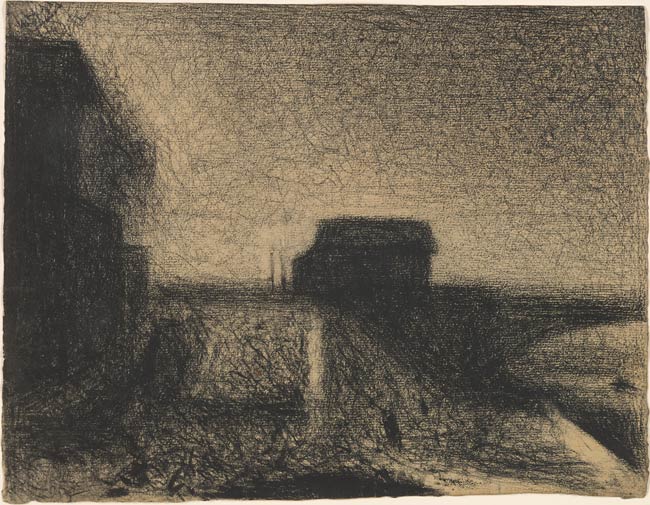

This densely worked sheet is Seurat's initial, independent view of the Pont Bineau at Courbevoie, the same site depicted in the artist's painting Bridge at Courbevoie, now in the Courtauld Galleries, London. Completed in 1886-the same year as the artist's masterpiece Sunday Afternoon on the Island of La Grande Jatte (Art Institute of Chicago)-the Bridge at Courbevoie was exhibited in the third Salon des Indépendants in March 1887. Here, the artist has focused on the bridge, whereas in a finished study preparatory for the painting (private collection) and in the painting itself, the bridge is displaced to the left background of the scene, allowing for a larger expanse of the river teeming with sailboats.
In the early 1880s, Seurat began exploring the villages along the banks of the Seine northwest of Paris, which the impressionists frequented. He made several studies in the immediate area around the small island of La Grand Jatte. The Pont Bineau joins Courbevoie to the island approximately at its middle. Seurat depicted the bridge and its environs in a small oil sketch from 1884 (Nationalmuseum, Stockholm) and in a small canvas and an oil sketch on wood from the following year (private collection; Berggruen collection) before he began the present study.
Executed in the artist's preferred technique of Conté crayon on textured paper, this study of the bridge may have been executed en plein air at Courbevoie: it is more vibrant than many of the artist's studies done in the studio. The composition achieves a balance between the vertical buildings seen in dramatic perspective along the quay at left, the horizontal thrust of the bridge that bisects the background, and the diagonal slope of the riverbank. The tollhouse on the bridge and the ambiguous vertical forms of what are perhaps smokestacks to the left stabilize the composition and contribute to its rhythmic tension.
The artist gave this drawing to his friend and ardent supporter, the critic Félix Fénéon, who first encountered Seurat and the group of painters later labeled neo-impressionists at the eighth and final exhibition of the impressionists in the spring of 1886. His review of the exhibition was largely a defense of La Grande Jatte, in which he stressed Seurat's innovative, almost mathematical technique. Fénéon continued to write about Seurat until 1890 when the two had a falling out: Seurat was concerned the critic had been too explicit about his technique and had failed to emphasize his role as leader of the group. Seurat died prematurely the following year.
Fénéon, Félix, 1861-1944, former owner.
Drey, Margaret H., former owner.
Courtauld, Samuel, former owner.
Kaufmann, Arthur, former owner.
Berggruen, Heinz, former owner.
Thaw, Eugene Victor, former owner.
Thaw, Clare, former owner.
The Morgan Library & Museum, New York, NY, "Drawn to Greatness: Master Drawings from the Thaw Collection", 2017. Exh. cat., no. 359, repr.
The Thaw Collection : Master Drawings and Oil Sketches : Acquisitions since 1994. New York : Pierpont Morgan Library, 2002, no. 51.
100 Master drawings from the Morgan Library & Museum. München : Hirmer, 2008, no. 94, repr. [Jennifer Tonkovich]
